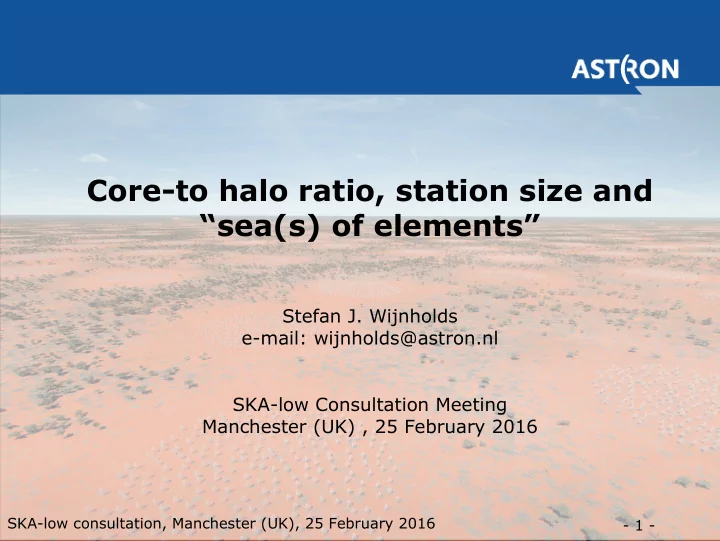

Core-to halo ratio, station size and “sea(s) of elements” Stefan J. Wijnholds e-mail: wijnholds@astron.nl SKA-low Consultation Meeting Manchester (UK) , 25 February 2016 SKA-low consultation, Manchester (UK), 25 February 2016 SKA-low consultation, Manchester (UK), 25 February 2016 - 1 - - 1 -
Outline Core-to-halo ratio ● – outer stations required for ionospheric calibration – outer stations required for imaging Station size ● – effect on psf sidelobe requirement – effect on ionospheric calibration – effect on observing capabilities Sea(s) of elements ● – effect on reconfigurability SKA-low consultation, Manchester (UK), 25 February 2016 - 2 -
Analysis of ionospheric calibration Analyses by Trott and Wijnholds answered the following questions: How many pierce points are required? ● How many pierce points are available? ● What is the SNR of those pierce points? ● How accurate can we solve ionospheric model parameters? ● Key conclusions (motivated in the next slides): The current outer stations provide sufficient spatial coverage. ● We may want to move some antennas from remote sites to the ● core to enhance EoR/CD and pulsar science capabilities. SKA-low consultation, Manchester (UK), 25 February 2016 - 3 -
Ionospheric model per station Wijnholds, SKA-low consultation, April 2015 Wijnholds, URSI AT-RASC, May 2015 For σ phase = 0.3, we need SNR ≈ 2.5 (in 10 s, 1 MHz) ● SKA-low consultation, Manchester (UK), 25 February 2016 - 4 -
Global ionospheric model Wijnholds, SKA-low consultation, April 2015 Assumptions ● - radius of array: 50 km - height of ionospheric phase screen: 200 km - HPBW of station: 0.17 rad (35-m station at 50 MHz) - patch size as fraction of TID wavelength: 0.1066 - TID wavelength: 120 km - 5 puncture points per patch we need about 551 puncture points for full array ● Proposed: 36 sites in outer are and a core ● Only 15 calibration sources needed (instead of 60!) ● SKA-low can detect over 160 sources @50 MHz: large headroom ● SKA-low consultation, Manchester (UK), 25 February 2016 - 5 -
Accuracy of global solution Analysis by Cathryn Trott More than sufficient calibration sources available (as expected) ● Relative error unnecessarily small for 10 s time scales ● – Clustering gives significant improvement at 50 MHz – Clustering reduces number of stations in inner area configuration frequency #calibrator amplitude precision rel. error (MHz) (rad) (rad) (%) Random51 50 44 0.27 2.7 ∙ 10 -5 0.01 150 67 0.03 8.3 ∙ 10 -6 0.03 250 31 0.01 3.8 ∙ 10 -5 0.4 Spiral94b 50 45 0.27 5.3 ∙ 10 -6 0.002 150 69 0.03 3.6 ∙ 10 -6 0.01 250 32 0.01 3.5 ∙ 10 -5 0.3 SKA-low consultation, Manchester (UK), 25 February 2016 - 6 -
Discussion core-to-halo ratio Observations: ionospheric calibration feasible with less sensitivity at outer sites ● EoR / CD and pulsar science benefit from more core sensitivity ● LOFAR-NL: 14 remote 41-m stations with 768 HBAs ● Survey speed (SS) ~ Ω (A/T) 2 ● – Even with 768-element stations, SS SKA > 7 SS LOFAR Recommendations: develop outer sites with 768 antennas (instead of 1536) ● add 27,648 antennas to core area ● Result: 79%/83% (V4D/V4A) collecting area in core (was 58%/62%) SKA-low consultation, Manchester (UK), 25 February 2016 - 7 -
Impact station size on PSN Wijnholds & Bregman, URSI GASS, August 2014 Option 1: 35-m stations with 256 antennas ● Option 2: 61-m stations with 768 antennas (same antenna density) ● larger stations: higher psf SLL, fewer subtractions for same psf SLL ● SKA-low consultation, Manchester (UK), 25 February 2016 - 8 -
Discussion on station size Large stations have smaller FoV ● – Puts lower requirement on psf SLL – Reduction of gridding costs (scales as D -2 to D -6 ) – Simplified ionospheric calibration (fewer patches) Large stations provide more reconfigurability ● – Use of substations – Tapering SKA-low consultation, Manchester (UK), 25 February 2016 - 9 -
Sea(s) of elements In V4A, each station consists of 6 substations ● – Correlating all substations requires 36x larger correlator – Observing with all substations not likely – Observing with substations will be done at lower sensitivity – Hence, we will likely not use all antennas Large stations / sea of elements in the core can be subdivided ● – Optimal: 20% – 25% of antennas not used – Subdivision is not restricted to “hard-wired” stations – Sea of elements (e.g., 200-m “superstation”) can provide many different station sizes / short baseline lengths Naturally, one would not opt for clumpy station configuration ● SKA-low consultation, Manchester (UK), 25 February 2016 - 10 -
Conclusions / recommendations Configuration with 768 antennas on sites in outer area ● – 61-m stations have density of 256-antenna 35-m stations Add 27,648 antennas to core area ● Consider stations larger than 35 m, small seas of elements ● – Advantageous for imaging, calibration and reconfigurability Consider a sea of elements / superstation of ~ 200 m in center ● – Substation size ranging from few meters to station size – Large number of diverse short baselines – Stations can be tapered to match substation size – Overall sensitivity still limited by correlator capacity – Very reconfigurable system: robust to new insights SKA-low consultation, Manchester (UK), 25 February 2016 - 11 -
Recommend
More recommend